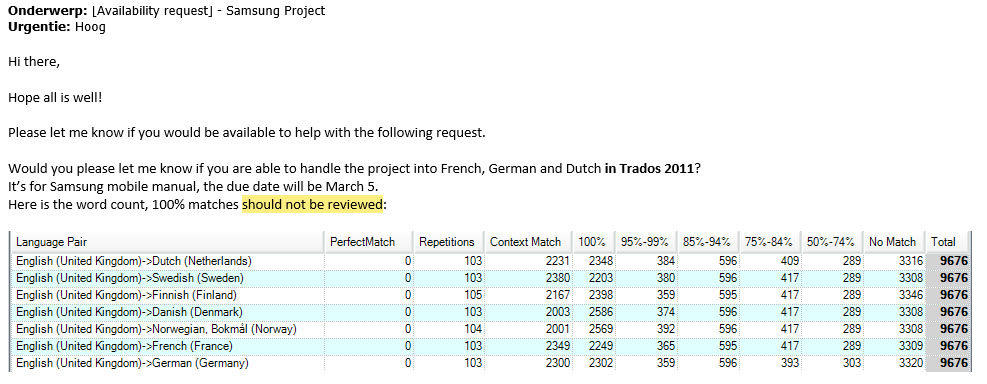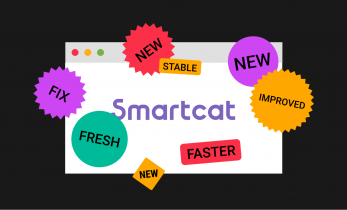Greater than 6 minutes, my friend!
One hundred per cent matches: the golden egg? Why 100 per cent matches should be paid
The development of CAT tools is one of the most advantageous developments in the translation industry until now. Splitting long texts in sentences improves their readability and efficiency while translating, while the archive of translations in memories offers loads of options for future use and reference. But the mathematical formulas that determine the similarity between two sentences are used more and more as a tool to offer lower prices to clients. Companies focusing on improving their margins or attracting more customers by putting 100% matches beyond their scopes are acting irresponsibly however, and even putting their clients at risk.
#Trados promotes paying for new content only. That's asking for troubles due to out of context matches, isn't it? pic.twitter.com/gymlIq8QAB
— Pieter Beens (@vertaaltnu) May 5, 2016
The pressure to decrease rates for repetitions
The idea behind this blog post was born last year, when I found the above advertisement by SDL at LinkedIn. In an attempt to promote their CAT tool among end users, SDL summed up a few benefits of computer-aided translation and translation memories: cost reduction, consistency, control and certainty. It must be said that Trados, like most other CAT software definitely offers these benefits. Using translation software can improve consistency and control and also lead to cost reduction. It must also be admitted that cost reduction for businesses at the cost of something else is not peculiar: indeed that is how business work. If you want to improve your margin on the one hand, you need to reduce costs on the other. CAT tools can be of great use then because they enable companies and translators alike to capitalize on existing translations and to deliver projects faster.
Those two aspects of the translation business have become more important in recent years. Companies not only want to reduce their costs for translations but at the same time they want to have their translations faster. CAT tools are offering part of the solution.
The calculation of matches and repetitions on a segment (sentence) level in translations however seems to focus only on costs. This is because the introduction of text analysis and similarity calculations for text companies have linked the existence of repetitions directly to a time and productivity gain for translators, which according to them should be reflected in lower prices. Translation agencies using “CAT tool repetition schemes” or even rejecting payment for 100% matches are now found everywhere.
The difficulty with 100 per cent matches
No matter how fair it might be to relate a time gain to a cost reduction, the idea of a discount in return for translation memory leverage has spread all over the market. Companies, whether they are end clients or translation companies, however do not seem to understand that what is calculated as a 100% match or repetition in a CAT tool is not necessarily a 100% fit in a certain context. That is what I found embarrassing about the advertisement by SDL.
In many cases segments that are a full repetition of a previous segment can be used without editing, which makes them a quick win for translators – and speeds up the translation process.
However, it becomes somewhat more difficult if the 100% matches are coming from a big translation memory or from projects that were translated a couple of years before.
Sometimes clients are used to translate technical manuals once every two or three years. In the meantime, changes can be introduced in word order, in terminology used or in other aspects which means that a 100% match from a translation memory cannot be used without editing it.
In other cases clients send a translation memory that was created by a different linguist who did not fully master the content of a translation project. Using 100% matches can then restrict translators in delivering a translation to the highest standards because leveraging the matches will introduce spelling errors or inconsistencies.
And sometimes it is simply the CAT tool that brings trouble. SDL Trados for instance counts values as 100% matches, but does not take localisation aspects into account. If such values are localised in different languages it still uses the notation format of the source text instead of the notation format of the translation. For instance, in English a value of one hundred dollar is written as $100, while in Dutch it is localised as $ 100; in a list with different dollar amounts Trados will automatically populate all 100% matching segments, but ignore the space between the dollar sign and the amount, which means that its translations need to be edited completely before they can be saved as a translation.
The existence of obvious 100% matches in texts therefore is not a real guarantee that they really don’t need editing and that they are a kind of low-hanging fruit for translators. On the other hand, 95–99% matches are often paid (albeit with a discount) and can sometimes be accepted without editing – offering more low-hanging fruit to translators than those infamous 100% matches.
When it comes values like those in money, weights, lengths and technical specifications, many translation agencies and end clients alike do not seem to understand the real value of localisation. Not an excuse but still helpful for those clients is that many customers do not understand those values either and take poor localisation for granted.
One hundred per cent matches however become more problematic if clients are not willing to pay for them while they really should be amended. Especially in bigger and more complex translation tasks and in jobs with a tighter deadline clients sometime prefer to ignore 100% matches and only focus on the segments that really need amendment or translation so as to gain time and save on costs. The impact can then be much bigger. Sometimes clients have an enormous translation memory containing all their translations, and use it for technical and creative translations alike. That sounds ridiculous, but it really happens that sometimes clients apply their technical memory to a translation job, locking out all 100% and ICE matches and only pay for the empty segments. Imagine what happens when a translation of “2 nuts” from a technical manual for a food processing machine is applied to a list with ingredients…
That is exactly what makes the biggest impact on companies. Of course they can reduce costs by requiring discounts for matches or even ignoring matches altogether, but that will increase the risk of harm to their business. Illegible manuals, inconsistent marketing campaigns and odd translations can lead to loss of customers, brand and reputation damage, and financial losses which could have been avoided by paying somewhat more money for paying somewhat more attention.
The right price for 100 per cent matches
Many businesses focusing on reducing costs by filtering out 100% matches are betting on a quick win and praise themselves when they save a few hundred dollars on a translation task. However, they underestimate the value of translators that look to 100% matches and repetitions thoroughly, improving and editing them where needed in order to make the translation flawless. In fact they focus blindly on saving some money, neglecting the chance of damage to their company as a result of poor translation management.
On the other hand, asking for a discount for matches has become usual, and can be understood from a business perspective as well. That leads to the question: what price for 100% matches is reasonable? Should such matches and repetitions be paid for in full or should translators and agencies alike offer a discount?
While a discount might sound attractive, there should be consideration given to the context of a whole project. If a 10,000 word document consists largely of tables with numerical repetitions, it seems reasonable to offer a discount. That is also the case if a client offers four slightly differing versions of a legal contract, where one should be translated and three others only need light editing. On the other hand, if document formatting is a problem or if specialist knowledge is required the discount should not be too much. And if clients are offered a discount for matches and repetitions it should not necessarily create the expectation that discounting on translations is the new standard. Depending on the task, offering a discount between 25 and 70% for repetitions might be a good idea. Nowadays a discount of around 50% even seems to be a common practice.
Whatever discount you choose to offer, make sure that clients do not see 100% matches and repetitions as a new golden egg in translations. And if it is your golden egg, then share enough of it to keep your clients but avoid clients taking it off your hands.








Quite a sensitive topic, this one, and definitely in need of more attention 🙂 I have lost count of the texts with locked 100% matches I’ve worked on, where the locked segments were not paid but often required editing… By the way, I’d missed that SDL infographic from last year, it’s hilarious that they listed consistency AND (basically) elimination of full matches together…
Thank you for your comment Eleonora. Those “locked segment” texts sound so familiar. I want to provide customers with the best possible translations I can offer, so if that means that I need to edit locked segments voluntarily I will do that. However, I am at crossroads now and wonder if I should let them go and see how it will go, whatever it will bring to the client (some clients even choose that option if I offer it and sum up the consequences…).
I say, let them lie in that bed, it’s their choice 🙂